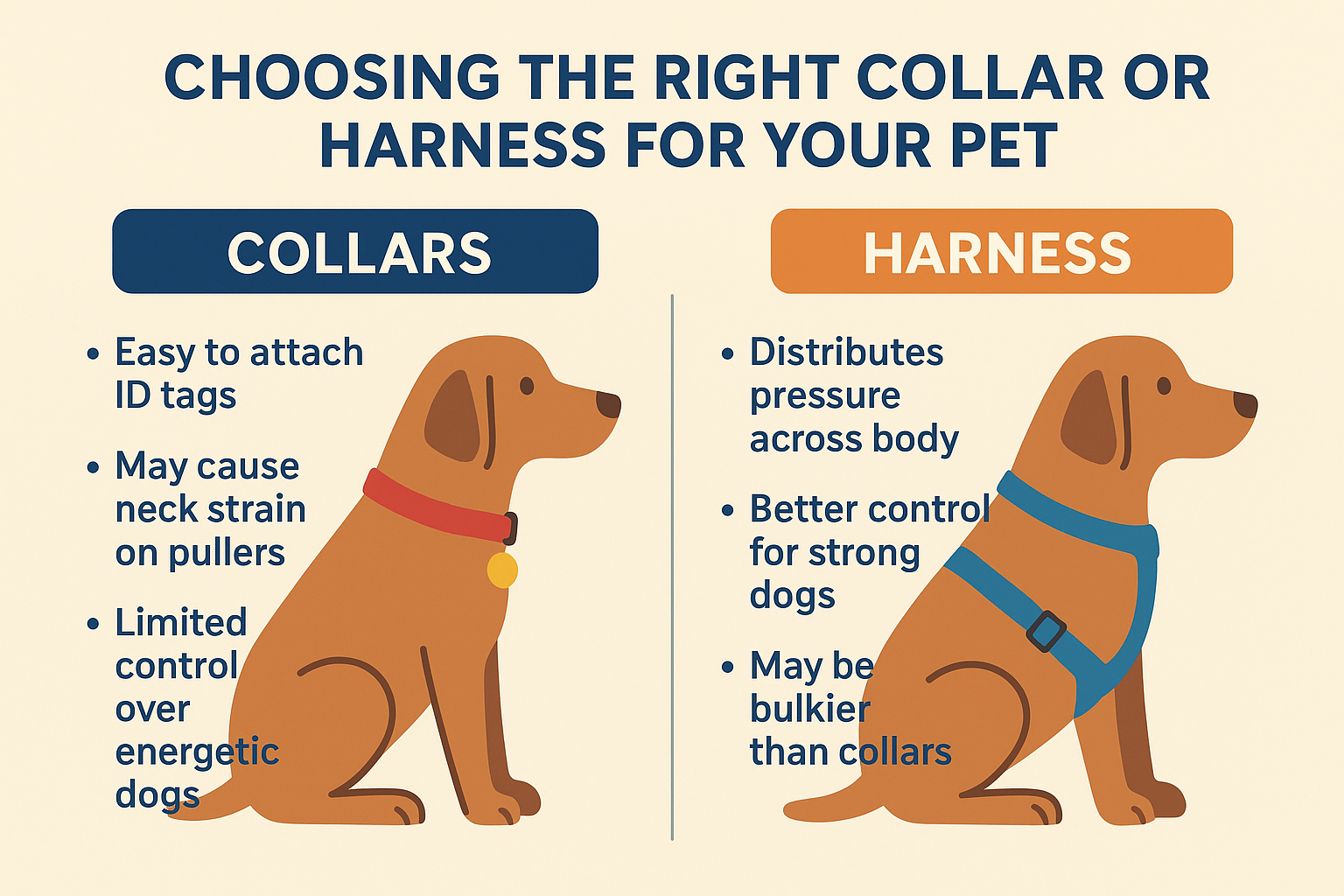When it comes to walking your dog or keeping them safe, one of the most important choices you’ll make as a pet parent is deciding whether to use a collar or a harness. Both have their advantages and drawbacks, and the right option often depends on your dog’s size, breed, temperament, and health. Understanding these differences can help you make a decision that prioritizes your pet’s safety, comfort, and overall well-being.
Collars: A Traditional Choice
Collars are the most common accessory for dogs and are available in a wide variety of styles and materials, such as nylon, leather, and even eco-friendly fabrics. A collar is a convenient way to attach ID tags, which are essential for quick identification if your dog gets lost.
Benefits of collars include:
- Simplicity: Easy to put on and remove.
- Identification: Collars hold tags and licenses.
- Training compatibility: Certain collars, like martingale collars, help prevent slipping out, making them suitable for dogs with narrow heads.
Limitations of collars:
- Pressure on the neck: Collars put strain on the throat, which may be harmful for small breeds, brachycephalic (flat-faced) dogs, or dogs prone to tracheal collapse.
- Pulling issues: Dogs that pull excessively may choke or injure themselves.
- Not ideal for all situations: For energetic dogs or those with respiratory problems, collars may not provide enough safety or control.
Harnesses: Support and Control
Harnesses have gained popularity as more pet owners recognize their safety and comfort advantages. Instead of putting pressure on the neck, a harness distributes weight across the dog’s chest and shoulders, which makes walking safer and more comfortable.
Benefits of harnesses include:
- Reduced strain: No pressure on the neck or windpipe, making them safer for small dogs, puppies, or dogs with respiratory conditions.
- Better control: Especially useful for strong or energetic dogs that tend to pull. Some harnesses even come with a front clip to discourage pulling behavior.
- Escape prevention: Harnesses are harder to slip out of than collars, making them safer for dogs that are skilled escape artists.
Limitations of harnesses:
- Less convenient: They can be trickier and more time-consuming to put on compared to collars.
- Not for 24/7 wear: Unlike collars, harnesses are bulkier and generally not comfortable for constant wear.
- Fit issues: An ill-fitting harness can cause rubbing, restricted movement, or discomfort if not properly adjusted.
Factors to Consider When Choosing
The decision between a collar and a harness is not always straightforward. Here are a few factors to help guide your choice:
- Dog’s Size and Breed: Small breeds like Chihuahuas or toy poodles may benefit more from harnesses to protect their fragile necks, while larger breeds may do well with sturdy collars if they are calm walkers.
- Health Conditions: Dogs with breathing issues, such as pugs or bulldogs, should avoid collars and use harnesses instead.
- Training Needs: If you are leash-training a puppy or a dog that pulls, a no-pull harness might make training easier.
- Lifestyle and Activities: For everyday wear and ID purposes, collars are practical. For hikes, runs, or long walks, a harness provides greater comfort and safety.
The Ideal Approach
Many pet owners find that using both a collar and a harness works best. The collar serves as a place for ID tags and short outings, while the harness is the go-to for walks, exercise, and situations where more control is necessary. Pairing the two ensures that your pet is always safe, comfortable, and secure.
Final Thoughts
Whether you choose a collar, a harness, or both, the most important thing is ensuring that your pet feels comfortable and safe. Always measure your dog carefully before purchasing, and make sure the fit is snug but not restrictive. Check for signs of irritation or discomfort after walks, and adjust as needed.


